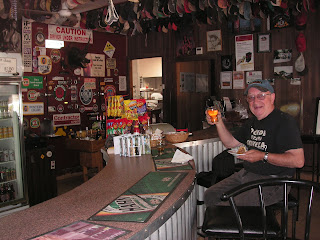

It may be the dry season in Kakadu, but when it’s “the wet” there must be water everywhere because when we went out to Mamukala to visit the bird hide there were huge billabongs and thousands of birds, which is not surprising considering that this area is the breeding ground for many species some of which come up from the Antarctic to breed. We enjoyed being able to watch the birds without them being aware that we were there.
We also drove up to Ubirr, famous for aboriginal rock art, of interest a thylacine or Tasmanian Tiger drawn thousands of years ago and of course now extinct. Another drawing of interest, a man with hat and cigar, obviously one of the early white explorers.
And then off to Darwin, my idea to stay in a city motel, as most caravan parks are some way out of the city, to be able to enjoy some of what the city has to offer in the evenings. So we are at Palms Motel, complete with en suite and TV but looking for chilli Mud Crab!!
By chance this week is one of cultural events for Darwin and yesterday we happened upon an exhibition of fabulous art from the TiWi Islands. About 80% of the exhibits had red stickers so a good feeling there and a young organizer suggested we might like to go to the evening awards ceremony. It took a bit of finding, and when we did some where to put the car was the next issue. We followed the crowd to find ourselves in a setting not unlike Elder Park, people picnicking on the grass in front of a stage with music and dance, but this time not by the River Torrens but by the sea with a magnificent sunset. An interesting combination of people, all the Darwin arty fartys, aboriginal artists and musicians and a few tourists like us. Unfortunately we didn’t realize the concept of the occasion and hadn’t brought anything to sit on or eat so after some enjoyment of the entertainment we headed off looking for dinner. We had been told that the Asian restaurant at the Casino was a good place to go - WELL - the Territorians obviously love to gamble if the number of cars in the car park was anything to go by and the young woman at the information booth said “all restaurants are booked out, ITS FRIDAY” so things didn’t look too good but we struck gold when we arrived at the maitre de’s station at the Chinese restaurant just as someone had cancelled their reservation so we were able to have their table. The food was pretty good too.
Twice a year in Darwin the Parliament, Government House and law Courts are open to the public and today was one of those days so we have spent the whole day being fascinated with listening to the Speaker of the House explain the running of the NT system, a judge talking about the issues which are faced in his court and finally afternoon tea with scones, jam and cream at Government House.
Sunday found us at the Chinese Temple and museum, they have been prominent in the community here and this evening a visit to the Mindil Beach Sunset Market.


















































